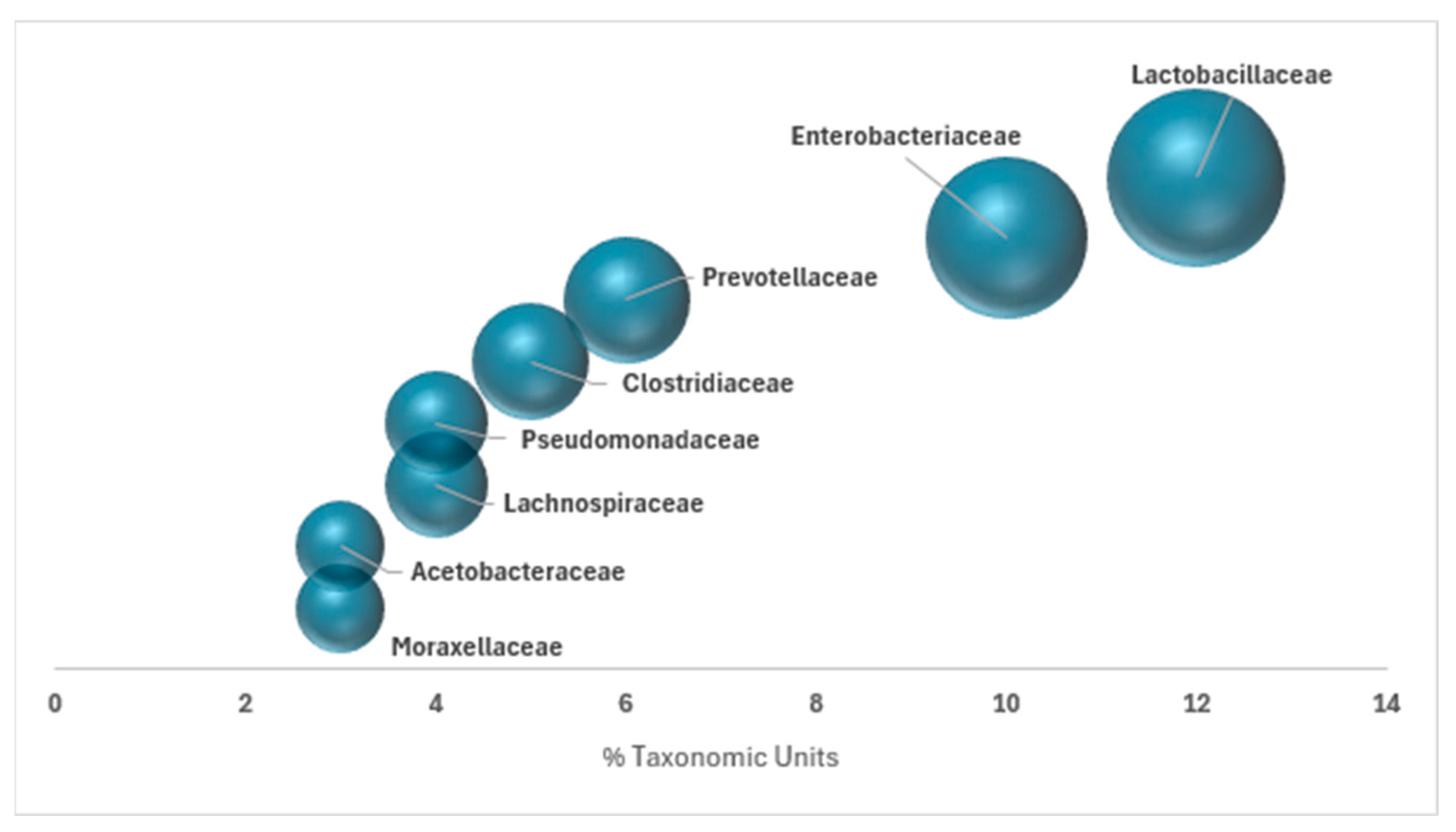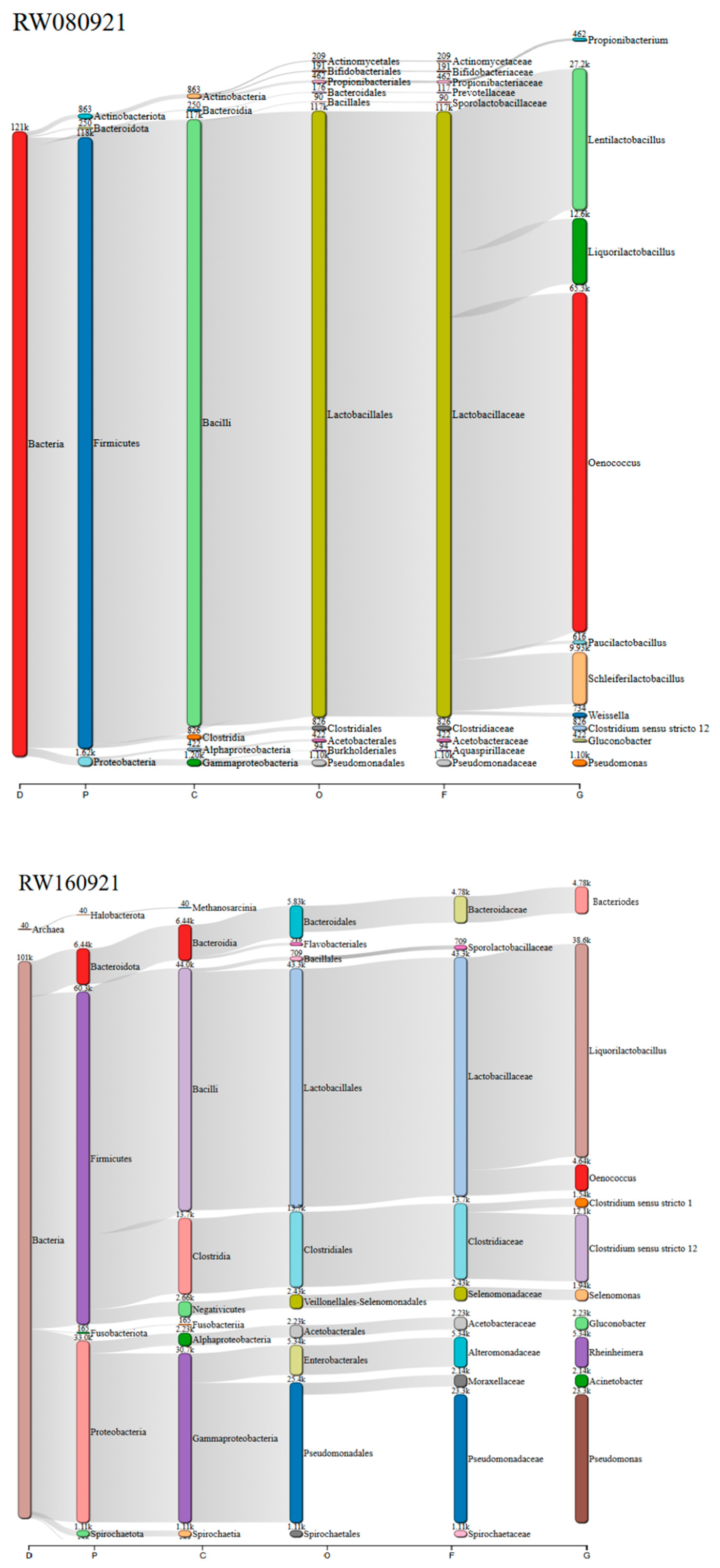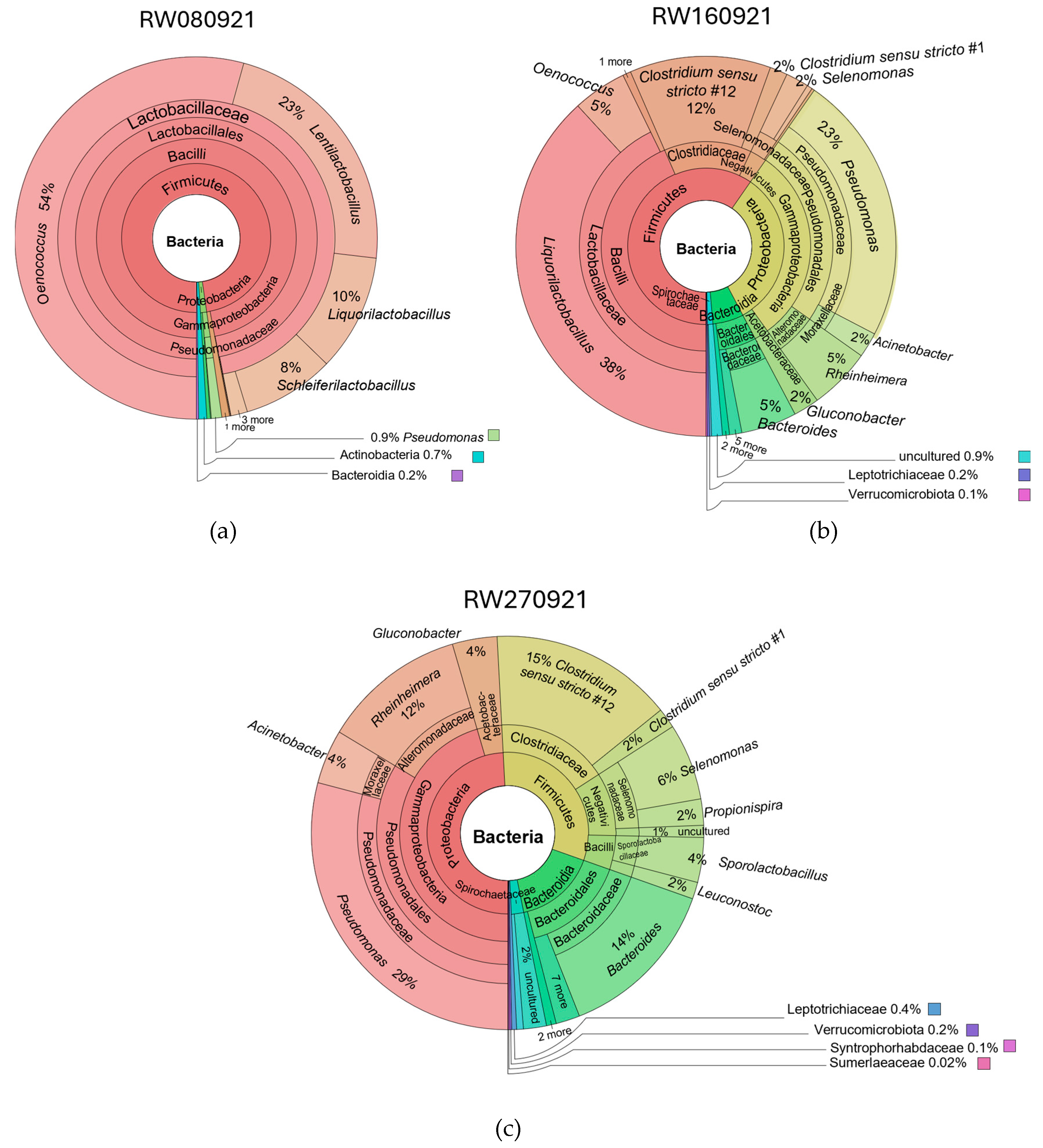Unveiling Bacterial Diversity in Portuguese Red Wine Effluents Through a Metagenomic Approach
Abstract
1. Introduction
2. Materials and Methods
2.1. Sample Characterisation
2.2. Sequencing and Metagenomics
2.3. Functional Comparative Genomic Analysis
3. Results and Discussion
3.1. Physicochemical Characterisation of Red Wine Effluents
3.2. Bacterial Taxonomic Identification
3.2.1. Overview of the Bacterial Community in the Composite Effluent Sample
3.2.2. Taxonomic Profiles of Individual Effluent Samples
3.2.3. Genome-Based Functional Analysis of Bacterial Communities in Winery Effluents
4. Conclusions
Author Contributions
Funding
Institutional Review Board Statement
Informed Consent Statement
Data Availability Statement
Acknowledgments
Conflicts of Interest
Abbreviations
| BLAST | Basic Local Alignment Search Tool |
| BV-BRC | Bacterial and Viral Bioinformatics Resource Centre |
| LAB | Lactic acid bacteria |
| MLF | Malolactic fermentation |
| NGS | Next-generation sequencing |
| OTU | Operational Taxonomic Units |
| PGF | Global families of proteins |
| RW | Red wine |
| SCFA | Short-chain fatty acid |
References
- Mekonnen, M.M.; Hoekstra, A.Y. Four billion people facing severe water scarcity. Sci. Adv. 2016, 2, e1500323. [Google Scholar] [CrossRef] [PubMed]
- Fonseca, A.; Andrade, C.; Santos, J.A. Agricultural Water Security under Climate Change in the Iberian Peninsula. Water 2022, 14, 768. [Google Scholar] [CrossRef]
- Amenorfenyo, D.K.; Huang, X.; Zhang, Y.; Zeng, Q.; Zhang, N.; Ren, J.; Huang, Q. Microalgae Brewery Wastewater Treatment: Potentials, Benefits and the Challenges. Int. J. Environ. Res. Public Health 2019, 16, 1910. [Google Scholar] [CrossRef] [PubMed]
- Costa, J.M.; Vaz, M.; Escalona, J.; Egipto, R.; Lopes, C.; Medrano, H.; Chaves, M.M. Modern viticulture in southern Europe: Vulnerabilities and strategies for adaptation to water scarcity. Agric. Water Manag. 2016, 164, 5–18. [Google Scholar] [CrossRef]
- Gudiukaite, R.; Nadda, A.K.; Gricajeva, A.; Shanmugam, S.; Nguyen, D.D.; Lam, S.S. Bioprocesses for the recovery of bioenergy and value-added products from wastewater: A review. J. Environ. Manag. 2021, 300, 113831. [Google Scholar] [CrossRef]
- Ortega-Farias, S.; Fereres, E.; Sadras, V.O. Special issue on water management in grapevines. Irrig. Sci. 2012, 30, 335–337. [Google Scholar] [CrossRef]
- Shoushtarian, F.; Negahban-Azar, M. Worldwide regulations and guidelines for agricultural water reuse: A critical review. Water 2020, 12, 971. [Google Scholar] [CrossRef]
- Bokulich, N.A.; Thorngate, J.H.; Richardson, P.M.; Mills, D.A. Microbial biogeography of wine grapes is conditioned by cultivar, vintage, and climate. Proc. Natl. Acad. Sci. USA 2014, 111, E139–E148. [Google Scholar] [CrossRef]
- Ioannou, L.A.; Puma, G.L.; Fatta-Kassinos, D. Treatment of winery wastewater by physicochemical, biological and advanced processes: A review. J. Hazard. Mater. 2015, 286, 343–368. [Google Scholar] [CrossRef]
- Rodrigues, A.C.; Oliveira, J.M.; Oliveira, J.A.; Pieixoto, J.; Nogueira, R.; Brito, A.G. Tratamento de Efluentes Vitivinícolas: Um caso de Estudo na Região dos Vinhos Verdes. Indústria e Ambiente. 2006. Available online: https://hdl.handle.net/1822/5877 (accessed on 15 June 2025).
- Sheridan, C.M.; Glasser, D.; Hildebrandt, D.; Petersen, J.; Rohwer, J. An Annual and Seasonal Characterisation of Winery Effluent in South Africa. S. Afr. J. Enol. Vitic. 2011, 32, 1–8. [Google Scholar] [CrossRef]
- Silva, M.; Oliveira-Inocêncio, I.; Martins, R.C.; Quinta-Ferreira, R.; Gmurek, M.; Nogueira, A.; Castro-Silva, S. Optimization of Heterogeneous Photosensitized Oxidation for Winery Effluent Treatment. Water 2023, 15, 2340. [Google Scholar] [CrossRef]
- Martins, A.R.; Sousa, A.C.; Gomes, A.G.; Cachão, M.; Santos, C.A. Approach for water sustainability in wine production by reusing its effluents for microalgae cultivation. In Proceedings of the WASTES: Solutions, Treatments and Opportunities, 6th International Conference, Coimbra, Portugal, 6–8 September 2023. [Google Scholar]
- Breznak, J.A.; Costilow, R.N. Physicochemical Factors in Growth. In Methods for General and Molecular Microbiology; ASM Press: Washington, DC, USA, 2007; pp. 309–329. [Google Scholar] [CrossRef]
- Islam, W.; Noman, A.; Naveed, H.; Huang, Z.; Chen, H.Y.H. Role of environmental factors in shaping the soil microbiome. Environ. Sci. Pollut. Res. 2020, 27, 41225–41247. [Google Scholar] [CrossRef]
- Bozoudi, D.; Tsaltas, D. Chapter 10—Grape Microbiome: Potential and Opportunities as a Source of Starter Cultures. In Grape and Wine Biotechnology; Morata, A., Loira, I., Eds.; InTech: Berlin, Germany, 2016. [Google Scholar] [CrossRef]
- Liu, Y.; Rousseaux, S.; Tourdot-Maréchal, R.; Sadoudi, M.; Gougeon, R.; Schmitt-Kopplin, P.; Alexandre, H. Wine microbiome: A dynamic world of microbial interactions. Crit. Rev. Food Sci. Nutr. 2017, 57, 856–873. [Google Scholar] [CrossRef] [PubMed]
- Swiegers, J.H.; Bartowsky, E.J.; Henschke, P.A.; Pretorius, I.S. Yeast and bacterial modulation of wine aroma and flavour. Aust. J. Grape Wine Res. 2005, 11, 139–173. [Google Scholar] [CrossRef]
- Stefanini, I.; Cavalieri, D. Metagenomic approaches to investigate the contribution of the vineyard environment to the quality of wine fermentation: Potentials and difficulties. Front. Microbiol. 2018, 9, 991. [Google Scholar] [CrossRef]
- Barata, A.; Malfeito-Ferreira, M.; Loureiro, V. The microbial ecology of wine grape berries. Int. J. Food Microbiol. 2012, 153, 243–259. [Google Scholar] [CrossRef]
- Morgan, H.H.; du Toit, M.; Setati, M.E. The Grapevine and Wine Microbiome: Insights from High-Throughput Amplicon Sequencing. Front. Microbiol. 2017, 8, 820. [Google Scholar] [CrossRef]
- Mandade, P.; Gnansounou, E. Chapter NINITEEN- Potential value-added products from wineries residues. In Biomass, Biofuels, Biochemicals; Elsevier: Amsterdam, The Netherlands, 2022; pp. 371–396. [Google Scholar] [CrossRef]
- Dubois, M.; Gilles, K.; Hamilton, J.K.; Rebers, P.A.; Smith, F. A Colorimetric Method for the Determination of Sugars. Nature 1951, 168, 167. [Google Scholar] [CrossRef]
- Miller, G.L. Use of Dinitrosalicylic Acid Reagent for Determination of Reducing Sugar. Anal. Chem. 1959, 31, 426–428. [Google Scholar] [CrossRef]
- Siddiqui, N.; Rauf, A.; Latif, A.; Mahmood, Z. Spectrophotometric determination of the total phenolic content, spectral and fluorescence study of the herbal Unani drug Gul-e-Zoofa (Nepeta bracteata Benth). J. Taibah Univ. Med. Sci. 2017, 12, 360–363. [Google Scholar] [CrossRef] [PubMed]
- Fadeev, E.; Cardozo-Mino, M.G.; Rapp, J.Z.; Bienhold, C.; Salter, I.; Salman-Carvalho, V.; Molari, M.; Tegetmeyer, H.E.; Buttigieg, P.L.; Boetius, A. Comparison of two 16S rRNA primers (V3–V4 and V4–V5) for studies of arctic microbial communities. Front. Microbiol. 2021, 12, 637526. [Google Scholar] [CrossRef]
- Bolyen, E.; Rideout, J.R.; Dillon, M.R.; Bokulich, N.A.; Abnet, C.C.; Al-Ghalith, G.A.; Alexander, H.; Alm, E.J.; Arumugam, M.; Asnicar, F.; et al. Reproducible, interactive, scalable and extensible microbiome data science using QIIME 2. Nat. Biotechnol. 2019, 37, 852–857. [Google Scholar] [CrossRef]
- Olson, R.D.; Assaf, R.; Brettin, T.; Conrad, N.; Cucinell, C.; Davis, J.J.; Dempsey, D.M.; Dickerman, A.; Dietrich, E.M.; Kenyon, R.W.; et al. Introducing the Bacterial and Viral Bioinformatics Resource Center (BV-BRC): A resource combining PATRIC, IRD and ViPR. Nucleic Acids Res. 2023, 51, D678–D689. [Google Scholar] [CrossRef]
- Welz, P.J.; Holtman, G.; Haldenwang, R.; le Roes-Hill, M. Characterisation of winery wastewater from continuous flow settling basins and waste stabilisation ponds over the course of 1 year: Implications for biological wastewater treatment and land application. Water Sci. Technol. 2016, 74, 2036–2050. [Google Scholar] [CrossRef]
- Bustamante, M.A.; Paredes, C.; Moral, R.; Moreno-Caselles, J.; Pérez-Espinosa, A.; Pérez-Murcia, M.D. Uses of winery and distillery effluents in agriculture: Characterisation of nutrient and hazardous components. Water Sci. Technol. 2005, 51, 145–151. [Google Scholar] [CrossRef] [PubMed]
- Sousa, A.C.; Dias, C.; Martins, A.R.; Gomes, A.G.; Santos, C.A. Using winery effluents for cultivating microalgae as bio-additives for vineyards. J. Appl. Phycol. 2025, 37, 1619–1632. [Google Scholar] [CrossRef]
- Kasote, D.; Ahmad, A.; Viljoen, A. Chapter 6- Proangiogenic potential of medicinal plants in wound healing. In Evidence-Based Validation of Herbal Medicine; Patwardhan, B., Ed.; Elsevier: Amsterdam, The Netherlands, 2015; pp. 149–164. [Google Scholar] [CrossRef]
- Lobiuc, A.; Pavăl, N.E.; Mangalagiu, I.I.; Gheorghiță, R.; Teliban, G.C.; Amăriucăi-Mantu, D.; Stoleru, V. Future antimicrobials: Natural and functionalized phenolics. Molecules 2023, 28, 1114. [Google Scholar] [CrossRef]
- Ueki, A.; Akasaka, H.; Satoh, A.; Suzuki, D.; Ueki, K. Prevotella paludivivens sp. nov., a novel strictly anaerobic, Gram-negative, hemicellulose-decomposing bacterium isolated from plant residue and rice roots in irrigated rice-field soil. Int. J. Syst. Evol. Microbiol. 2007, 57, 1803–1809. [Google Scholar] [CrossRef]
- Ueki, A.; Tonouchi, A.; Kaku, N.; Ueki, K. Prevotella herbatica sp. nov., a plant polysaccharide-decomposing anaerobic bacterium isolated from a methanogenic reactor. Int. J. Syst. Evol. Microbiol. 2022, 72, 005221. [Google Scholar] [CrossRef] [PubMed]
- Sousa, M.A.D.; Rama, G.R.; Volken de Souza, C.F.; Granada, C.E. Acid lactic lactobacilli as a biotechnological toll to improve food quality and human health. Biotechnol. Prog. 2020, 36, e2937. [Google Scholar] [CrossRef]
- Chen, M.-J.; Lin, Y.-C.; Hsieh, H.-H. Biologically Pure Lactobacillus Mali Strain and Composition Thereof for Treating Metabolic Syndrome. U.S. Patent 9,884,079B2, 6 February 2018. [Google Scholar]
- Chen, M.; Lin, Y.; Hsieh, H. Novel Lactobacillus mali APS1 and Use Thereof. Taiwan Patent TWI559925B, 1 December 2016. [Google Scholar]
- Xu, X.; Peng, Q.; Zhang, Y.; Tian, D.; Zhang, P.; Huang, Y.; Ma, L.; Qiao, Y.; Shi, B. A novel exopolysaccharide produced by Lactobacillus coryniformis NA-3 exhibits antioxidant and biofilm-inhibiting properties in vitro. Food Nutr. Res. 2020, 64, 10-29219. [Google Scholar] [CrossRef] [PubMed]
- Du, Y.; Zou, W.; Zhang, K.; Ye, G.; Yang, J. Advances and Applications of Clostridium Co-culture Systems in Biotechnology. Front. Microbiol. 2020, 11, 560223. [Google Scholar] [CrossRef]
- Ueki, A.; Abe, K.; Ohtaki, Y.; Kaku, N.; Watanabe, K.; Ueki, K. Bacteroides paurosaccharolyticus sp. nov., isolated from a methanogenic reactor treating waste from cattle farms. Int. J. Syst Evol. Microbiol. 2011, 61, 448–453. [Google Scholar] [CrossRef]
- Murali, N.; Srinivas, K.; Ahring, B.K. Biochemical production and separation of carboxylic acids for biorefinery applications. Fermentation 2017, 3, 22. [Google Scholar] [CrossRef]
- Mohany, M.; Aslam, J.; Ali, M.A.; Khattak, B.; Fozia, F.; Ahmad, I.; Khan, M.D.; Al-Rejaie, S.S.; Ziaullah, Z.; Milošević, M. Wastewater microbiology: Occurrence and prevalence of antibiotic-resistant extended-spectrum β-lactamase-producing Enterobacteriaceae in the district wastewater system. J. Water Health. 2025, 23, 26–42. [Google Scholar] [CrossRef]
- Paramithiotis, S.; Stasinou, V.; Tzamourani, A.; Kotseridis, Y.; Dimopoulou, M. Malolactic Fermentation—Theoretical Advances and Practical Considerations. Fermentation 2022, 8, 521. [Google Scholar] [CrossRef]
- Zheng, J.; Wittouck, S.; Salvetti, E.; Franz, C.M.; Harris, H.M.; Mattarelli, P.; Lebeer, S.A. taxonomic note on the genus Lactobacillus: Description of 23 novel genera, emended description of the genus Lactobacillus Beijerinck 1901, and union of Lactobacillaceae and Leuconostocaceae. Int. J. Syst. Evol. Microbiol. 2020, 70, 2782–2858. [Google Scholar] [CrossRef]
- Bernardeau, M.; Vernoux, J.P.; Henri-Dubernet, S.; Guéguen, M. Safety assessment of dairy microorganisms: The Lactobacillus genus. Int. J. Food Microbiol. 2008, 126, 278–285. [Google Scholar] [CrossRef] [PubMed]
- Grenda, T.; Grenda, A.; Domaradzki, P.; Krawczyk, P.; Kwiatek, K. Probiotic potential of Clostridium spp.—Advantages and doubts. Curr. Issues Mol. Biol. 2022, 44, 3118–3130. [Google Scholar] [CrossRef] [PubMed]
- Ren, X.; Palmer, L.D. Acinetobacter metabolism in infection and antimicrobial resistance. Infect. Immun. 2023, 91, e00433-22. [Google Scholar] [CrossRef]
- Chen, W.M.; Lin, C.Y.; Young, C.C.; Sheu, S.Y. Rheinheimera aquatica sp. nov., antimicrobial activity-producing bacterium isolated from freshwater culture pond. J. Microbiol. Biotechnol. 2010, 20, 1386–1392. [Google Scholar] [CrossRef]
- Pinto, C.; Pinho, D.; Cardoso, R.; Custódio, V.; Fernandes, J.; Sousa, S.; Pinheiro, M.; Egas, C.; Gomes, A.C. Wine fermentation microbiome: A landscape from different portuguese wine appellations. Front. Microbiol. 2015, 6, 905. [Google Scholar] [CrossRef]
- Altschul, S.F.; Gish, W.; Miller, W.; Myers, E.W.; Lipman, D.J. Basic local alignment search tool. J. Mol. Biol. 1990, 215, 403–410. [Google Scholar] [CrossRef]
- Capozzi, V.; Russo, P.; Lamontanara, A.; Orrù, L.; Cattivelli, L.; Spano, G. Genome Sequences of Five Oenococcus oeni Strains Isolated from Nero Di Troia Wine from the Same Terroir in Apulia, Southern Italy. Genome Announc. 2014, 2, 10-1128. [Google Scholar] [CrossRef] [PubMed]
- Cousin, F.J.; Le Guellec, R.; Chagnot, C.; Goux, D.; Dalmasso, M.; Laplace, J.-M.; Cretenet, M. Oenococcus sicerae sp. nov., isolated from French cider. Syst. Appl. Microbiol. 2019, 42, 302–308. [Google Scholar] [CrossRef]
- Carballo, J.; Martin, R.; Bernardo, A.; Gonzalez, J. Purification, characterization and some properties of diacetyl(acetoin) reductase from Enterobacter aerogenes. Eur. J. Biochem. 1991, 198, 327–332. [Google Scholar] [CrossRef] [PubMed]
- Giovannini, P.P.; Medici, A.; Bergamini, C.M.; Rippa, M. Properties of diacetyl (acetoin) reductase from Bacillus stearothermophilus. Bioorg. Med. Chem. 1996, 4, 1197–1201. [Google Scholar] [CrossRef]
- Zhao, X.; Zhang, X.; Rao, Z.; Bao, T.; Li, X.; Xu, M.; Yang, T.; Yang, S. Identification and characterization of a novel 2,3-butanediol dehydrogenase/acetoin reductase from Corynebacterium crenatum SYPA5-5. Lett. Appl. Microbiol. 2015, 61, 573–579. [Google Scholar] [CrossRef]
- Buron-Moles, G.; Chailyan, A.; Dolejs, I.; Forster, J.; Mikš, M.H. Uncovering carbohydrate metabolism through a genotype-phenotype association study of 56 lactic acid bacteria genomes. Appl. Microbiol. Biotechnol. 2019, 103, 3135–3152. [Google Scholar] [CrossRef] [PubMed]







| Sample ID | pH | Conductivity (mS/cm) | Reducing Sugars (g/L) | Total Sugars (g/L) | Total Phenolic Content (g/L) |
|---|---|---|---|---|---|
| RW080921 | 4.57 | 1.46 | 4.45 ± 0.25 | 8.61 ± 0.02 | 0.195 ± 0.002 |
| RW160921 | 4.68 | 0.99 | 0.13 ± 0.00 | 0.55 ± 0.00 | 0.122 ± 0.003 |
| RW270921 | 4.36 | 1.59 | 0.17 ± 0.00 | 0.53 ± 0.00 | 0.251 ± 0.003 |
Disclaimer/Publisher’s Note: The statements, opinions and data contained in all publications are solely those of the individual author(s) and contributor(s) and not of MDPI and/or the editor(s). MDPI and/or the editor(s) disclaim responsibility for any injury to people or property resulting from any ideas, methods, instructions or products referred to in the content. |
© 2025 by the authors. Licensee MDPI, Basel, Switzerland. This article is an open access article distributed under the terms and conditions of the Creative Commons Attribution (CC BY) license (https://creativecommons.org/licenses/by/4.0/).
Share and Cite
Gomes, A.G.; Sousa, A.C.; Carreira, J.S.; Oliveira, A.; Justino, M.C.; Santos, C.A. Unveiling Bacterial Diversity in Portuguese Red Wine Effluents Through a Metagenomic Approach. Microorganisms 2025, 13, 2192. https://doi.org/10.3390/microorganisms13092192
Gomes AG, Sousa AC, Carreira JS, Oliveira A, Justino MC, Santos CA. Unveiling Bacterial Diversity in Portuguese Red Wine Effluents Through a Metagenomic Approach. Microorganisms. 2025; 13(9):2192. https://doi.org/10.3390/microorganisms13092192
Chicago/Turabian StyleGomes, Ana Gabriela, Ana Cláudia Sousa, João S. Carreira, Alberto Oliveira, Marta C. Justino, and Carla Amarelo Santos. 2025. "Unveiling Bacterial Diversity in Portuguese Red Wine Effluents Through a Metagenomic Approach" Microorganisms 13, no. 9: 2192. https://doi.org/10.3390/microorganisms13092192
APA StyleGomes, A. G., Sousa, A. C., Carreira, J. S., Oliveira, A., Justino, M. C., & Santos, C. A. (2025). Unveiling Bacterial Diversity in Portuguese Red Wine Effluents Through a Metagenomic Approach. Microorganisms, 13(9), 2192. https://doi.org/10.3390/microorganisms13092192






